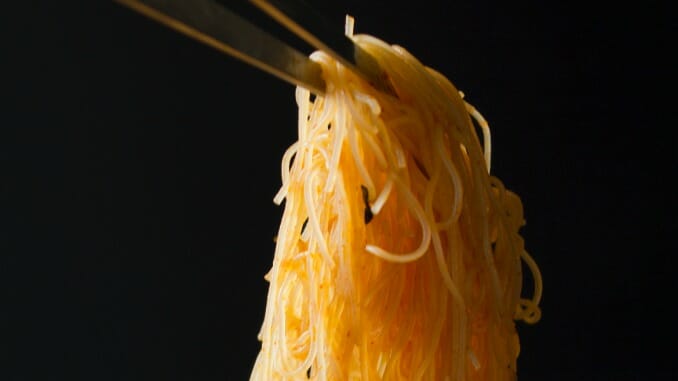Untangling the Mystery of Singapore Noodles
Photo by Sharon Murillo/Pexels
On any given list of the world’s best food capitals, Singapore is undeniably one of the top gastronomic powerhouses. The city-state boasts an incredible food scene that reflects its unique cultural fabric. It’s also home to one of the cheapest Michelin-starred meals in the world—a S$6 (US$4.50) bowl of bak chor mee from hawker stall Hill Street Tai Hwa Pork Noodle.
The famous street food dish is typically served dry with noodles lovingly tossed in vinegar and cooked with pork mince, mushrooms and morsels of decadent deep-fried lard. Along with other popular noodle dishes such as the spicy laksa (curried noodle soup with coconut milk) and the smoky char kway teow (stir-fried flat noodles), bak chor mee is easily available around the island.
However, one particular noodle dish that is all but unknown in the Lion City is the one that is eponymously named “Singapore noodles.” It’s a stir-fried rice vermicelli tossed in heaps of curry powder, the ingredient responsible for the dish’s violent yellow hue.
Abroad, the dish seems to have become a permanent fixture on the menus of Chinese takeaways and restaurants in the U.S., UK, Australia and Hong Kong. Having lived in London for almost a decade now, it feels like there is no escaping this curried rice vermicelli—it’s even readily available in supermarkets, and celebrity chef Jamie Oliver has his own take on it.
I first tasted Singapore noodles when homesickness kicked in a month after moving to London from the Motherland. Scanning the menu of a Chinese takeaway with an inviting sign that said “Malaysian and Singaporean cuisine,” I landed upon the Singapore noodles. Out of curiosity (and homesickness), I ordered it.
Unfortunately, it did not taste like home. Instead, it tasted like a bad combination of instant noodle seasonings—an absolute sacrilege. Disappointed, I fed it to the bin and never revisited it again.
Despite what it says on the tin, its origins aren’t found in Singapore or anywhere else in Southeast Asia. Instead, its roots can be traced to a different island state: Hong Kong. It’s been said that the recipe was born after World War II when the then British colony was becoming a booming trading hub. With spices and curries from the previously British-ruled India being added to the southern Chinese pantry, cooks were looking for different ways to utilize the ingredients.
Cue Singapore noodles. Despite having as many different variations as the many different cooks who prepare it, the two main ingredients across the board are rice vermicelli and curry powder. Due to the simplicity of the dish, it soon became popular among laborers who needed cheap, carb-heavy meals for sustenance. It also accompanied the Chinese diaspora to the Western world, making its debut in Chinese takeaways and restaurants.